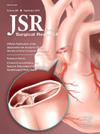猪肾自体移植手术的精细化——在已建立的训练计划中使学习曲线变平
IF 1.7
3区 医学
Q2 SURGERY
引用次数: 0
摘要
复杂的动物模型,如猪肾自体移植(pRaTx)模型,为转化研究提供了一个很好的平台。pRaTx模型是具有挑战性的,它提供了许多可能性来改进手术程序,优化学习曲线和结果。在这项研究中,我们描述了使pRaTx学习曲线平坦化的关键初始步骤。方法根据主刀医师的经验水平,将51例德国长白猪pRaTx连续手术分为两组。监测所有手术步骤的持续时间,移植物和受体的结果,并指出具体的陷阱和可能的改进方法。结果:P <;两组在热缺血(28.0(24.0-34.5)vs 40.0(34.5-47.0) min)和吻合时间(27.0(22.0-33.0)vs 38.0(33.0-44.0) min)方面差异均为0.05。因此,2组动物的滞留参数较高。然而,这些差异并没有体现在“硬”临床结果上,如血管并发症、生存率。两组均需10例左右才能获得稳定的手术表现。结论机器灌注入路和异种移植已成为临床关注的焦点,建立可靠、可重复的pRaTx模型对pRaTx的转化研究至关重要。正如我们所展示的,pRaTx模型需要一个优化的团队方法来改进过程。本文章由计算机程序翻译,如有差异,请以英文原文为准。
Surgical Refinement in Porcine Renal Autotransplantation – Flattening the Learning Curve in an Established Training Program
Introduction
Complex animal models, such as the porcine renal autotransplantation (pRaTx) model, provide an excellent platform for translational research. The pRaTx model is challenging, offering many possibilities to refine surgical procedures and optimize learning curves and outcomes. In this study, we described the critical initial steps toward flattening the learning curve in pRaTx.
Methods
We performed 51 consecutive cases of pRaTx in German landrace pigs divided between two teams, based on the experience level of the lead surgeon. Duration of all surgical steps, graft and recipient outcomes were monitored and specific pitfalls and possible refinement approaches were pointed out.
Results
Significant (P < 0.05) differences were observed between team-1/2 concerning warm-ischemia (28.0(24.0-34.5) versus 40.0(34.5-47.0) min) and anastomosis times (27.0(22.0-33.0) versus 38.0(33.0-44.0) min). Consequently, retention parameters were higher in the animals of team-2. Nevertheless, these differences did not manifest in “hard” clinical outcomes, such as vascular complications, survival. About 10 cases were required in both teams for a stable surgical performance.
Conclusions
As machine perfusion approaches and xenotransplantation are increasing in the spotlight of clinical interest, setting up a reliable and reproducible model for pRaTx is critical for translational research. As we could show, the pRaTx model requires an optimized team approach to refine the procedure.
求助全文
通过发布文献求助,成功后即可免费获取论文全文。
去求助
来源期刊
CiteScore
3.90
自引率
4.50%
发文量
627
审稿时长
138 days
期刊介绍:
The Journal of Surgical Research: Clinical and Laboratory Investigation publishes original articles concerned with clinical and laboratory investigations relevant to surgical practice and teaching. The journal emphasizes reports of clinical investigations or fundamental research bearing directly on surgical management that will be of general interest to a broad range of surgeons and surgical researchers. The articles presented need not have been the products of surgeons or of surgical laboratories.
The Journal of Surgical Research also features review articles and special articles relating to educational, research, or social issues of interest to the academic surgical community.

 求助内容:
求助内容: 应助结果提醒方式:
应助结果提醒方式:


